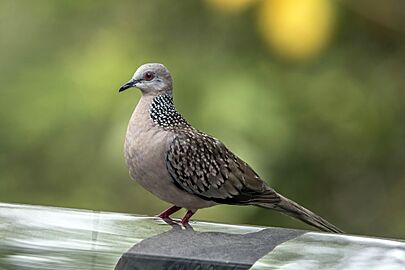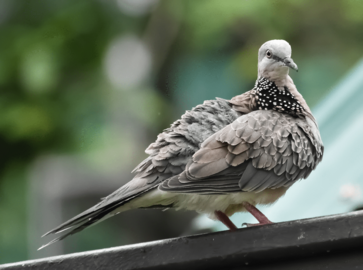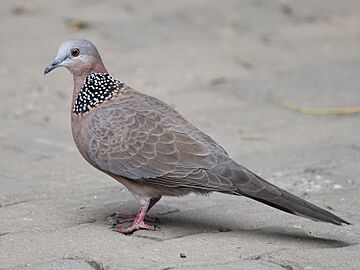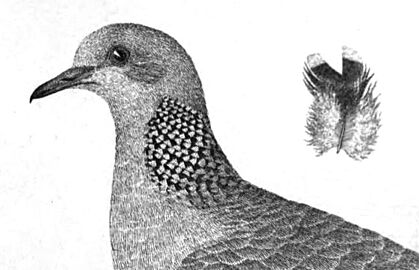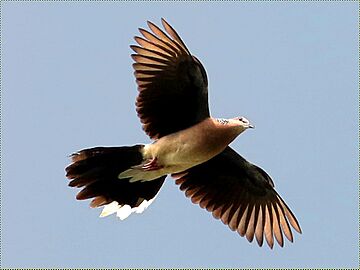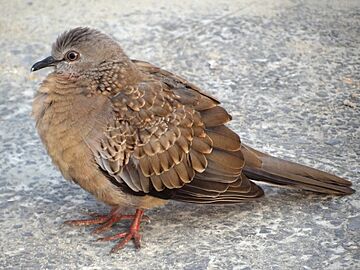Spotted dove facts for kids
Quick facts for kids Spotted dove |
|
|---|---|
 |
|
| Spilopelia chinensis suratensis, a type of spotted dove found in India. | |
| Conservation status | |
| Scientific classification | |
| Genus: |
Spilopelia
|
| Species: |
chinensis
|
| Subspecies | |
|
See text |
|
| Synonyms | |
|
|
The spotted dove, also known as the eastern spotted dove (Spilopelia chinensis), is a small pigeon with a long tail. It is a common bird found all year round in its native home on the Indian subcontinent and across East and Southeast Asia. People have introduced the species to many other parts of the world, where it has started new wild populations.
This bird was once grouped with other turtle-doves in the Streptopelia genus. However, recent studies showed it was different enough to be moved to its own group. The spotted dove is a light brownish-pink color. Its most famous feature is a black patch on the back and sides of its neck, which is covered in white spots. The tips of its tail feathers are white, and its wings have light brown spots.
Different groups of spotted doves can look slightly different depending on where they live. They are often found in light forests, gardens, and even in cities. When they take off from the ground, their wings make a loud flutter. Sometimes they will glide down to a branch to rest. This bird has many nicknames, including mountain dove, pearl-necked dove, and lace-necked dove.
Contents
Naming and Types of Spotted Doves
The spotted dove was officially named in 1786 by an Austrian scientist named Giovanni Antonio Scopoli. He gave it the scientific name Columba chinensis.
Scientists who study animals, called zoologists, often group them based on how they are related. For a long time, the spotted dove was in the genus Streptopelia. But in 2001, a study of the bird's DNA showed that it was not as closely related to the other doves in that group as they thought. To make the groups more accurate, the spotted dove and the similar laughing dove were moved to their own genus, Spilopelia.
Because spotted doves live over a very large area, different populations have developed unique appearances and sizes. These different types are called subspecies.
Main Subspecies
There are five official subspecies of the spotted dove:
- S. c. suratensis – Found in Pakistan, India, Nepal, and Bhutan.
- S. c. ceylonensis – Lives in Sri Lanka and has shorter wings than the Indian type.
- S. c. tigrina – Found from Bangladesh and northeast India all the way to the Philippines and the Sunda Islands.
- S. c. chinensis – The "original" subspecies from China. It is also the type that was introduced to Hawaii.
- S. c. hainana – Lives on the island of Hainan, near China.
The subspecies from India and Sri Lanka look and sound quite different from the others. Some bird experts even think they should be considered a completely separate species, called the western spotted dove.
-
S. c. tigrina
Kuala Lumpur, Malaysia -
S. c. chinensis
Zhengzhou, China
What Do Spotted Doves Look Like?
The spotted dove is a slim bird, about 28 to 32 centimeters (11 to 13 inches) long. Its body is mostly a pinkish-brown color that becomes gray on its head and belly.
The most noticeable feature is the black "half-collar" on its neck. This patch is made of special black feathers that split at the end, with a white spot on each tip, making it look like a lace collar. In the doves from India and Sri Lanka, the feathers on the upper wings also have reddish-brown spots.
The main flight feathers on the wings are dark brown with gray edges. The belly and the area under the tail are white. When the dove flies, you can see the white tips on its outer tail feathers. Male and female doves look the same. Young birds are a bit duller in color and don't get their neck spots until they grow up.
Where Do Spotted Doves Live?
In their native home in Asia, spotted doves live in many different places, including forests, farmlands, and even towns. In India, they prefer areas with more moisture. They spend a lot of time on the ground, searching for seeds and grains to eat.
Introduced Populations
The spotted dove has been introduced to many places outside of Asia. It has successfully formed wild populations in:
- Hawaii
- Southern California
- Mauritius (an island in the Indian Ocean)
- Australia
- New Zealand
In Australia, the birds were first brought to Melbourne in the 1860s. Since then, they have spread across the eastern and southern parts of the country. They are now a common sight in parks, gardens, and city streets.
Behavior and Lifestyle
Spotted doves are usually seen in pairs or small groups. They walk on the ground to find food, which includes grass seeds, grains, and fallen fruit. They might also eat insects, like winged termites.
Their flight is quick and steady. To impress a mate, a male will perform a special display flight. He flies steeply upwards, making a loud clapping sound with his wings, and then glides slowly back down with his tail spread wide.
Life Cycle and Reproduction
In warm places, spotted doves can breed all year long. In areas with cooler seasons, they usually breed in the summer. To attract a female, a male will coo, bow his head, and perform his flying display.
They build a simple nest out of twigs, usually in a low bush or tree. Sometimes they will even build nests on the ground or on buildings. The female lays two white eggs. Both the male and female help build the nest, sit on the eggs to keep them warm (incubation), and feed the chicks.
The eggs hatch in about 13 days. The young birds, called fledglings, are ready to leave the nest after about two weeks. A pair of spotted doves can raise several groups of chicks, called broods, in one year.
What Do Spotted Doves Sound Like?
The call of the spotted dove is a soft cooing sound. The Indian subspecies has a call that sounds like Krookruk-krukroo... kroo kroo kroo. The types of doves found further east have a simpler call without the final kroos.
Because they are so successful, spotted doves have been able to spread to many new areas. Their habit of suddenly flying up when scared can sometimes be a problem at airports, where they might fly into the path of airplanes.




